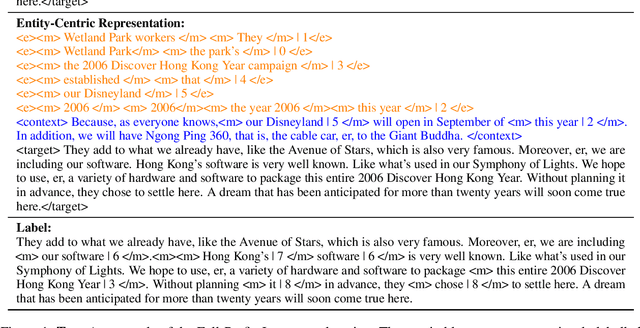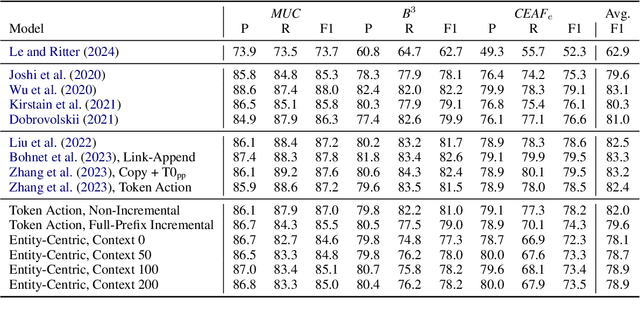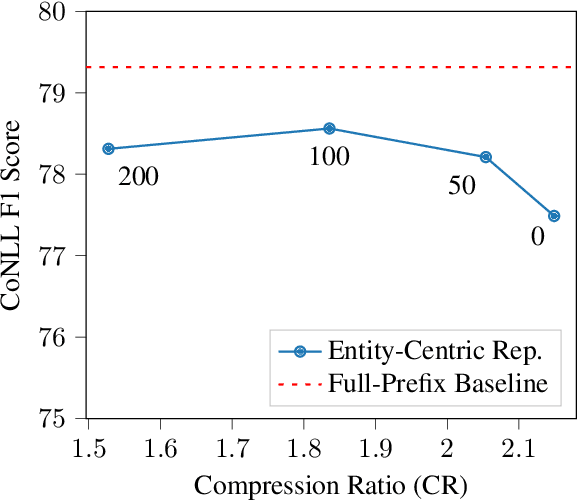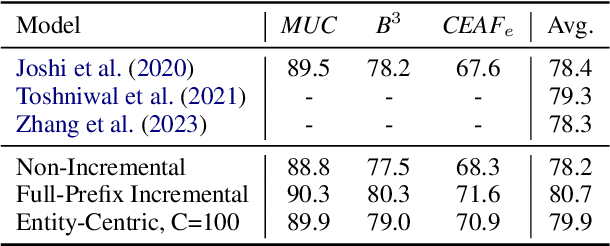Shay B. Cohen
Efficient Seq2seq Coreference Resolution Using Entity Representations
Oct 16, 2025



Abstract:Seq2seq coreference models have introduced a new paradigm for coreference resolution by learning to generate text corresponding to coreference labels, without requiring task-specific parameters. While these models achieve new state-of-the-art performance, they do so at the cost of flexibility and efficiency. In particular, they do not efficiently handle incremental settings such as dialogue, where text must processed sequentially. We propose a compressed representation in order to improve the efficiency of these methods in incremental settings. Our method works by extracting and re-organizing entity-level tokens, and discarding the majority of other input tokens. On OntoNotes, our best model achieves just 0.6 CoNLL F1 points below a full-prefix, incremental baseline while achieving a compression ratio of 1.8. On LitBank, where singleton mentions are annotated, it passes state-of-the-art performance. Our results indicate that discarding a wide portion of tokens in seq2seq resolvers is a feasible strategy for incremental coreference resolution.
ONNX-Net: Towards Universal Representations and Instant Performance Prediction for Neural Architectures
Oct 06, 2025Abstract:Neural architecture search (NAS) automates the design process of high-performing architectures, but remains bottlenecked by expensive performance evaluation. Most existing studies that achieve faster evaluation are mostly tied to cell-based search spaces and graph encodings tailored to those individual search spaces, limiting their flexibility and scalability when applied to more expressive search spaces. In this work, we aim to close the gap of individual search space restrictions and search space dependent network representations. We present ONNX-Bench, a benchmark consisting of a collection of neural networks in a unified format based on ONNX files. ONNX-Bench includes all open-source NAS-bench-based neural networks, resulting in a total size of more than 600k {architecture, accuracy} pairs. This benchmark allows creating a shared neural network representation, ONNX-Net, able to represent any neural architecture using natural language descriptions acting as an input to a performance predictor. This text-based encoding can accommodate arbitrary layer types, operation parameters, and heterogeneous topologies, enabling a single surrogate to generalise across all neural architectures rather than being confined to cell-based search spaces. Experiments show strong zero-shot performance across disparate search spaces using only a small amount of pretraining samples, enabling the unprecedented ability to evaluate any neural network architecture instantly.
One More Question is Enough, Expert Question Decomposition (EQD) Model for Domain Quantitative Reasoning
Oct 01, 2025Abstract:Domain-specific quantitative reasoning remains a major challenge for large language models (LLMs), especially in fields requiring expert knowledge and complex question answering (QA). In this work, we propose Expert Question Decomposition (EQD), an approach designed to balance the use of domain knowledge with computational efficiency. EQD is built on a two-step fine-tuning framework and guided by a reward function that measures the effectiveness of generated sub-questions in improving QA outcomes. It requires only a few thousand training examples and a single A100 GPU for fine-tuning, with inference time comparable to zero-shot prompting. Beyond its efficiency, EQD outperforms state-of-the-art domain-tuned models and advanced prompting strategies. We evaluate EQD in the financial domain, characterized by specialized knowledge and complex quantitative reasoning, across four benchmark datasets. Our method consistently improves QA performance by 0.6% to 10.5% across different LLMs. Our analysis reveals an important insight: in domain-specific QA, a single supporting question often provides greater benefit than detailed guidance steps.
PiCSAR: Probabilistic Confidence Selection And Ranking
Aug 29, 2025Abstract:Best-of-n sampling improves the accuracy of large language models (LLMs) and large reasoning models (LRMs) by generating multiple candidate solutions and selecting the one with the highest reward. The key challenge for reasoning tasks is designing a scoring function that can identify correct reasoning chains without access to ground-truth answers. We propose Probabilistic Confidence Selection And Ranking (PiCSAR): a simple, training-free method that scores each candidate generation using the joint log-likelihood of the reasoning and final answer. The joint log-likelihood of the reasoning and final answer naturally decomposes into reasoning confidence and answer confidence. PiCSAR achieves substantial gains across diverse benchmarks (+10.18 on MATH500, +9.81 on AIME2025), outperforming baselines with at least 2x fewer samples in 16 out of 20 comparisons. Our analysis reveals that correct reasoning chains exhibit significantly higher reasoning and answer confidence, justifying the effectiveness of PiCSAR.
Iterative Multilingual Spectral Attribute Erasure
Jun 12, 2025Abstract:Multilingual representations embed words with similar meanings to share a common semantic space across languages, creating opportunities to transfer debiasing effects between languages. However, existing methods for debiasing are unable to exploit this opportunity because they operate on individual languages. We present Iterative Multilingual Spectral Attribute Erasure (IMSAE), which identifies and mitigates joint bias subspaces across multiple languages through iterative SVD-based truncation. Evaluating IMSAE across eight languages and five demographic dimensions, we demonstrate its effectiveness in both standard and zero-shot settings, where target language data is unavailable, but linguistically similar languages can be used for debiasing. Our comprehensive experiments across diverse language models (BERT, LLaMA, Mistral) show that IMSAE outperforms traditional monolingual and cross-lingual approaches while maintaining model utility.
PersonaLens: A Benchmark for Personalization Evaluation in Conversational AI Assistants
Jun 11, 2025Abstract:Large language models (LLMs) have advanced conversational AI assistants. However, systematically evaluating how well these assistants apply personalization--adapting to individual user preferences while completing tasks--remains challenging. Existing personalization benchmarks focus on chit-chat, non-conversational tasks, or narrow domains, failing to capture the complexities of personalized task-oriented assistance. To address this, we introduce PersonaLens, a comprehensive benchmark for evaluating personalization in task-oriented AI assistants. Our benchmark features diverse user profiles equipped with rich preferences and interaction histories, along with two specialized LLM-based agents: a user agent that engages in realistic task-oriented dialogues with AI assistants, and a judge agent that employs the LLM-as-a-Judge paradigm to assess personalization, response quality, and task success. Through extensive experiments with current LLM assistants across diverse tasks, we reveal significant variability in their personalization capabilities, providing crucial insights for advancing conversational AI systems.
Bootstrapping World Models from Dynamics Models in Multimodal Foundation Models
Jun 06, 2025Abstract:To what extent do vision-and-language foundation models possess a realistic world model (observation $\times$ action $\rightarrow$ observation) and a dynamics model (observation $\times$ observation $\rightarrow$ action), when actions are expressed through language? While open-source foundation models struggle with both, we find that fine-tuning them to acquire a dynamics model through supervision is significantly easier than acquiring a world model. In turn, dynamics models can be used to bootstrap world models through two main strategies: 1) weakly supervised learning from synthetic data and 2) inference time verification. Firstly, the dynamics model can annotate actions for unlabelled pairs of video frame observations to expand the training data. We further propose a new objective, where image tokens in observation pairs are weighted by their importance, as predicted by a recognition model. Secondly, the dynamics models can assign rewards to multiple samples of the world model to score them, effectively guiding search at inference time. We evaluate the world models resulting from both strategies through the task of action-centric image editing on Aurora-Bench. Our best model achieves a performance competitive with state-of-the-art image editing models, improving on them by a margin of $15\%$ on real-world subsets according to GPT4o-as-judge, and achieving the best average human evaluation across all subsets of Aurora-Bench.
Integrating Counterfactual Simulations with Language Models for Explaining Multi-Agent Behaviour
May 23, 2025Abstract:Autonomous multi-agent systems (MAS) are useful for automating complex tasks but raise trust concerns due to risks like miscoordination and goal misalignment. Explainability is vital for trust calibration, but explainable reinforcement learning for MAS faces challenges in state/action space complexity, stakeholder needs, and evaluation. Using the counterfactual theory of causation and LLMs' summarisation capabilities, we propose Agentic eXplanations via Interrogative Simulation (AXIS). AXIS generates intelligible causal explanations for pre-trained multi-agent policies by having an LLM interrogate an environment simulator using queries like 'whatif' and 'remove' to observe and synthesise counterfactual information over multiple rounds. We evaluate AXIS on autonomous driving across 10 scenarios for 5 LLMs with a novel evaluation methodology combining subjective preference, correctness, and goal/action prediction metrics, and an external LLM as evaluator. Compared to baselines, AXIS improves perceived explanation correctness by at least 7.7% across all models and goal prediction accuracy by 23% for 4 models, with improved or comparable action prediction accuracy, achieving the highest scores overall.
Transferrable Surrogates in Expressive Neural Architecture Search Spaces
Apr 18, 2025Abstract:Neural architecture search (NAS) faces a challenge in balancing the exploration of expressive, broad search spaces that enable architectural innovation with the need for efficient evaluation of architectures to effectively search such spaces. We investigate surrogate model training for improving search in highly expressive NAS search spaces based on context-free grammars. We show that i) surrogate models trained either using zero-cost-proxy metrics and neural graph features (GRAF) or by fine-tuning an off-the-shelf LM have high predictive power for the performance of architectures both within and across datasets, ii) these surrogates can be used to filter out bad architectures when searching on novel datasets, thereby significantly speeding up search and achieving better final performances, and iii) the surrogates can be further used directly as the search objective for huge speed-ups.
Theorem Prover as a Judge for Synthetic Data Generation
Feb 18, 2025Abstract:The demand for synthetic data in mathematical reasoning has increased due to its potential to enhance the mathematical capabilities of large language models (LLMs). However, ensuring the validity of intermediate reasoning steps remains a significant challenge, affecting data quality. While formal verification via theorem provers effectively validates LLM reasoning, the autoformalisation of mathematical proofs remains error-prone. In response, we introduce iterative autoformalisation, an approach that iteratively refines theorem prover formalisation to mitigate errors, thereby increasing the execution rate on the Lean prover from 60% to 87%. Building upon that, we introduce Theorem Prover as a Judge (TP-as-a-Judge), a method that employs theorem prover formalisation to rigorously assess LLM intermediate reasoning, effectively integrating autoformalisation with synthetic data generation. Finally, we present Reinforcement Learning from Theorem Prover Feedback (RLTPF), a framework that replaces human annotation with theorem prover feedback in Reinforcement Learning from Human Feedback (RLHF). Across multiple LLMs, applying TP-as-a-Judge and RLTPF improves benchmarks with only 3,508 samples, achieving 5.56% accuracy gain on Mistral-7B for MultiArith, 6.00% on Llama-2-7B for SVAMP, and 3.55% on Llama-3.1-8B for AQUA.
 Add to Chrome
Add to Chrome Add to Firefox
Add to Firefox Add to Edge
Add to Edge